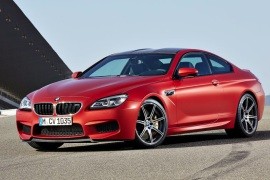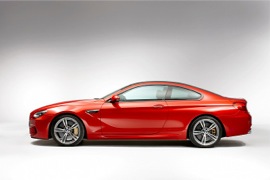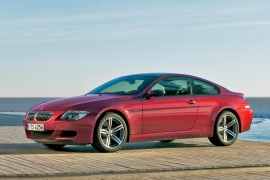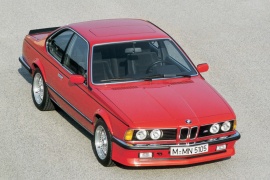BMW M6 Coupe Models/Series Timeline, Specifications & Photos
First production year: 1984
Engines: Gasoline
Body style: Coupé (two-door)
When BMW unveiled the mid-life cycle impulse for the M6 in 2014, it did more than just adding a few styling cues to the car; it introduced a special, more powerful version as well.
The German carmaker introduced the first 6-Series in 1976 and lasted until 1989 when it was withdrawn from the market without a clear successor, until 2003 when BMW unveiled the second generation. This time, it continued the saga in 2011 with the third generation and refreshed it in 2014. But it didn't come alone. It brought the updated M6 and the new Gran Coupe with it.
While the convertible and the Gran Coupe were additional versions, the coupe remained the true performer of the family. Even though it was more of a gran-tourer, it was still a performance car. The refreshed version received new LED headlights as standard, along with a slightly reshaped front bumper. From its sides, the carmaker introduced a new set of light-alloy wheels with a seven-spoke design.
Inside, the M6 featured a new steering wheel with paddle shifters for the dual-clutch gearbox. Also, on the center console, the carmaker placed the specific M gear-selector. As an additional reminder, the instrument panel sported the M-badge on the black dial background. The Merino leather-clad interior and the sport bucket seats matched the car's exclusive look.
Under the hood, BMW offered a Competition Package for the M6, which raised the power by 40 hp. As an option, the carmaker removed the speed limiter for this version, boosting the top speed up to 189 mph (304 kph). Unlike its regular M-sibling, the Competition Package version featured an active M Differential for better traction.
The second generation of the BMW's Grand Tourer M6 was launched in 2012. Unlike its predecessor that offered a screaming naturally aspirated V10 engine, the 2012 version featured a twin-turbo V8.
The world of performance GT cars could not be complete without a representative from the BMW. With tons of power and luxurious interior, the M6 was a good mix between a high-performance sports car and a grand tourer.
Unlike the rest of the 6-Series, the M6 offered a meaner look. The chrome-rounded kidney-grille, the side M-badges on the front fenders, and the four exhausts in the back were part of the package. The 20” light-alloy wheels were also fitted as standard. A lip-spoiler on the trunk added some aggressive stance to the car. The headlights were offered as an option with LED. To lighten the car on top of it, the roof was made out of CFRP (Carbon Fiber Reinforced Plastic).
Inside, the bolstered seats installed in the front helped the driver and the side passenger to keep their position while hard cornering. With the standard leather upholstery, the cabin looked luxurious. There were two seats in the back but without too much leg or headroom.
The magic of the M6 came from a newly developed V8 engine with two turbochargers installed between the cylinder banks, to reduce the turbo-lag. The gasoline direct injection system also helped for better performance. The differential was controlled by a computer and a multi-plate clutch system, that allowed a locking between 0 and 100 %.
For years and years, BMW fans asked the German car maker to bring back the 6 Series, whose production was stopped in 1989. In 2003 it returned and, in 2005 it was unleashed with a mighty V10 engine in the form of the M6.
The first generation of the 6 Series didn't have an M6. It had an M635 CSI, which was almost the same thing. But the first, true, M6 was introduced at the 2005 Geneva Motor Show. It was more than an upgraded version of a 6 Series. It was almost a completely different car. It shared some parts with the less-powered versions, but most of it was different.
For starters, the roof was made out of carbon fiber to lower the center of gravity. The front and rear bumpers were different and so were the side sills. A different set of wheels and a quad-exhaust completed the package. Like all the M-vehicles, it didn't have any big wing on the trunk, but there was an underbody aerodynamic package to increase downforce. And it didn't matter that the overall design was not one of the best in the company's history.
Inside, the M6 was available in a 2+2 configuration. The front bucket-seats featured high bolstering to keep the occupants in place while hard cornering. The leather upholstery was carefully crafted to enhance the luxury. The M6 was supposed to be more of a GT than a sports car, but it managed to be more on the performance side.
The technology inside was at the top level. It started with a naturally aspirated 5.0-liter V10 engine mated to a 7-speed SMG (single-clutch automated gearbox) fitted as standard in Europe. A 6-speed manual was available in the U.S. The suspension was stiffened to cope with the high-performance engine.
BMW installed the M1's supercar powerplant in the engine bay of a 6 Series, upgraded its brakes and suspension, and that's how one of the most iconic German vehicles was born in 1984: the M635 CSi.
The M-badged version was more powerful and luxurious than the rest of the 6 Series range. It was also more expensive than its stablemates and costlier than the M5, which was a four-door sedan powered by the same powerplant. The carmaker started to produce it in 1984, and the updated engine added more than 60 ponies over the regular 635 CSi. Furthermore, the carmaker used this version as a base to compete successfully in racing.
Even though it sported the same shape as the rest of the 6 Series range from 1977, this M version was slightly different. At the front, the four headlamps were available with wipers and washers. Underneath the chromed bumper, BMW installed a lower spoiler that minimized the ground effect. In addition, it installed a set of rectangular fog lamps. It also came standard with BBS light-alloy wheels.
Inside, the dashboard tilted toward the driver, the bolstered front seats, and the individual chairs for the rear-seated passengers were all unique for the 6 Series. Yet, the M version raised the bar a little bit more by adding standard leather upholstery and an onboard diagnosis system. That was unusual. BMW offered the vehicle with a standard tape player and air conditioning. The sunroof was an option, though.
Its engine was carried over from the magic BMW M1. But thanks to the electronic fuel injection system, the M88/3 inline-six powerplant provided more power than the carmaker's first supercar. Power was sent to the rear wheels only via an LSD.



